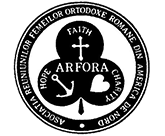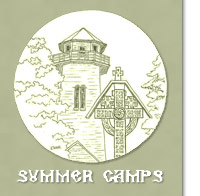De
Mortuis Nihil Nisi Bonum
(Speak Only Well of the Dead)
(A response to an article published in the Mitropolia Banatului Review, sent on July 27, 2011)
Not long ago, I read an article published in Mitropolia Banatului Review, no. 22,
(LXII, new series, January-March, 2011). On pages 7-11 of this publication, I
found a homage to the late metropolitan and writer Bartolomeu Anania, entitled In Memoriam, written by Fr. Horia Ţâru. I read it with interest and appreciated its content, but I was
troubled by some statements that could have been omitted, just so that we would
let the dead rest in peace. I am writing to inform you that the article has
some problems of both accuracy and methodology.
I do not wish to minimize the richness or the merit of the homage itself, nor do I bring under the magnifying glass these academic minuses for any reason other than that – unfortunately – they offend the image of the great Romanian Hierarch Valerian D. Trifa as well as that of the Romanian Orthodox Episcopate of America. Given the fact that it is printed in a well-known Orthodox Metropolitanate journal, the respective article could add an undesirable toxic potential to the dialogue of reconciliation of the two Romanian Orthodox dioceses in America. For this reason, I believe clarification is necessary, and I beg you to publish it as a letter to the editor.
As he describes the missionary activity in America of the former Archimandrite Valeriu Anania, between 1964-1975, Fr. Horia Ţâru textually reproduces the personal and drastic impressions of the reposed writer about Archbishop Valerian Trifa (see Valeriu Anania, Memorii, p. 361), but he neglects to use proper quotations. In doing so, not only does he, perhaps inadvertantly, plagiarize, but he also makes assertions without discernment, conveying some factually false statements to the uninformed reader, which I will try to dispel below. Here is the text of the paragraph in question: “Valerian Trifa did not have valid apostolic succession, and did not possess divine grace; consequently he had all qualities except for one: he was not a bishop” (M.B., nr. 22, p. 10). In this matter, I believe that Metropolitan Bartolomeu Anania was conveying his own prejudice in line with the black and white stereotype that characterized the Stalinist period. Fr. Ţâru’s error is that by re-circulating such statements without warning the reader, he takes this statement too far for our times, losing sight of the fact that today, those realities are far better known and are much more sensibly interpreted. His statement could offend the hierarchs and clergy ordained by Archbishop Trifa. It also casts a shadow over the irenic ties between the hierarchs of the Romanian Orthodox Church and the Romanian Orthodox Episcopate of America.
Regardless of how uncomfortable this might be for some, the Romanian Orthodox Episcopate of America, which – after 1947 – was the only segment of the Romanian Orthodox Church uncontrolled by communism, rejects this untruth. We wish to clarify that in the year 1964, the moment captured by the memories of the late hierarch from Cluj, Archbishop Valerian had already been a part of the Holy Synod of the Russian Metropolia and thus, a Hierarch of this canonical jurisdiction, recognized as such by SCOBA. His personality was re-evaluated in the Romanian theological historiography by the great historian Fr. Professor Dr. Mircea Pacurariu, in The Encyclopedia of Romanian Orthodoxy (Bucharest, Editura Institutului Biblic si de Misiune al BOR, 2010, p.662) as well as by other authoritative sources that present him as a worthy hierarch and successor of Bishop Policarp Morusca (who was retained in Romania against his will). For further edification, I recommend the reader to my volume: “Policarp Morusca, Letters from Captivity,” Cluj-Napoca, Eikon, 2004.
The second clarification I wish to underscore regards the allusions made in the memoirs of Metropolitan Anania to “the lost Shepherd” (Archbishop Valerian Trifa) and “the lost sheep” , a remark attributed to Archbishop Valerian (referring to Archimandrite Valeriu Anania). Such wrangling must not be understood today as anything other than a personal exchange between two clerics who, in the context of the breaks between the long theological conferences in Uppsala, Sweden, were afforded the opportunity for diplomatic dueling, a jocularity with teeth, in the spirit of those years. One should not forget that the same Metropolitan Anania, on the same page, did not hesitate to describe Valerian as a “young bishop, educated, intelligent, enterprising, ambitious, a good organizer and good orator...” (Valeriu Anania, Memorii, p. 361). When removed from the context, this dialogue could be easily misinterpreted.
Finally, I wish to mention that although the memoirs of Valeriu Anania could also have another interpretation from an American perspective, at this time I do not wish to add any further comments, not to disturb his repose, or defile his memory (De Mortuis Nihil Nisi Bonum). In this spirit, my intent in this letter was but to clarify the distortions regarding Archbishop Trifa and his Episcopate, which since 1984 has been shepherded by His Eminence Archbishop Nathaniel Popp. I hope my notes remind all of us of the importance of context and quotations, but even moreso about our great calling to “honor those who rule over us” (Heb. 13,7), especially when they cannot defend themselves. I send my gratitude to the editor for publishing this response, which is intended to bring in balance again the perspective of the situation created by the article witten by Fr. Ţâru (otherwise well articulated), and to possibly minimize the potential toxic interpretations which might arise in the context of the ongoing dialogue between the two sister dioceses in North America.
V. Rev. Fr. Dr. Remus Grama
External Affairs Representative
Romanian Orthodox Episcopate of America
De Mortuis Nihil Nisi Bonum
(Un raspuns la un articol publicat in revista Mitropolia Banatului trimis pe 27 Iulie 2011)
Nu de mult, mi-a căzut
în mână un articol publicat în Revista Altarul Banatului, nr. 22, (LXII), serie
noua, ianuarie-martie, 2011. Am găsit la paginile 7-11 ale revistei un
omagiu intitulat In memoriam, adus de
preotul Horia Ţâru, mitropolitului şi
scriitorului Bartolomeu Anania al Clujului. L-am citit cu interes şi i-am gustat conţinutul,
dar am fost tulburat de anumite afirmaţii care s-ar fi putut
omite, ca sa-I lăsăm pe cei morţI să doarmă
în pace. De aceea, vă scriu spre a semnala faptul că prezentarea are câteva
scadenţe, atât din punct de vedere metodologic, cât şi faptic.
Descriind activitatea misionară desfăşurată în America de fostul Arhimandrit Valeriu Anania, între anii 1964-1975, Părintele Horia Ţâru transcrie textual drasticele impresii personale ale răposatului ierarh despre Arhiepiscopul Valerian Trifa (vezi Anania, Memorii, p. 361), uitând însă, să le aşeze între ghilimele. Prin aceasta, nu numai că se plagiază, probabil inadvertent, ci autorul îşi şi împropriază fără a discerna aserţiunea, transmiţând astfel cititorului neavizat unele neadevăruri, pe care mă voi strădui să le clarific mai jos. Iată ce spune acel paragraf: “Valerian Trifa nu avea hirotonie validă, nu avea sucesiune apostolică, nu era posesor al harului dumnezeiesc, prin urmare avea toate calităţile, în afară de una singură pur şi simplu nu era episcop” (M.B., nr. 22, p 10). Considerăm că în aceasta chestiune Mitropolitul Anania îşi transmitea prejudecata potrivit cu stereotipul alb-negru specific anilor stalinismului. Greşeala Părintelui Ţâru este ca, recirculând asemenea afirmaţii fără ca să avizeze pe cititor, el merge cu această afirmaţie prea departe pentru vremurile de astăzi, când realităţile de atunci sunt mult mai sensibil interpretate şi mai bine cunoscute. Afirmaţia poate ofensa şi pe anumiţi ierarhi şi preoţi sfinţiţi de Arhiepiscopul Trifa. Ea umbreşte şi legăturile irenice dintre BOR şi Episcopia din America, la nivel de ierarhie.
Episcopia Ortodoxă Română de la Vatra Românească, care - după 1947 - a fost singurul segment necontrolat de comunism al Bisericii Ortodoxe Române, respinge acest neadevăr, oricât ar fi de necomfortabil pentru unii. Precizăm că, în anul 1964, moment la care se referă memoriile ierarhului clujean, Arhiepiscopul Valerian D.Trifa era déjà membru al Sfântului Sinod al Mitropoliei Ruseşti din America, fiind aşadar Ierarh al acestei Biserici canonice, recunoscute de SCOBA. Personalitatea sa a fost re-evaluată şi de istoriografia teologică românească prin marele istoric Pr. Prof. Dr. Acad. Mircea Pacurariu, în Enciclopedia Ortodoxiei Romaneşti (Buc., Editura Institutului Biblic şi de Misiune al BOR, 2010, p. 662), precum şi în alte surse autoritative, care îl prezintă ca pe un vrednic ierarh şi succesor al Episcopului Policarp Morusca (reţinut captiv în România, împotriva voinţei sale). Pentru edificare, recomand cititorilor si lucrarea mea, intitulată “Policarp Moruşca, Scrisori din Captivitate,” Cluj-Napoca, Eikon, 2004.
A doua clarificare pe care doresc să o semnalez este cea privitoare la aluziile făcute de Mitropolitul Anania la “Păstorul rătăcit” (Arhiepiscopul Valerian Trifa) şi “oaia cea pierdută,” remarcă aparţinătoare arhiepiscopului Trifa (cu privire la arhimandritul Valeriu Anania). Acestea altercaţii nu trebuie înţelese astăzi decât ca persiflări personale, pe care cei doi clerici şi le permiteau unul faţă de altul, în contextul intim al ceasurilor de relaxare dintre lungile conferinte teologice de la Uppsala. Aş zice că ele sunt un fel de umor diplomatic, oarecum cu dinţi, cum se obişnuia în acei ani. Totuşi nu trebuie uitat că acelaşi mitropolit, Anania, n-a ezitat sa-l descrie pe Valerian, pe aceaşi pagină, ca pe un “episcop tânăr, cult, inteligent, intreprinzător, ambiţios, bun organizator şi bun orator…” (Anania, Memorii, p. 361). Extras din context, acest dialog poate fi uşor răstălmăcit.
În final, doresc să menţionez că deşi Memoriile mitropolitului Bartolomeu Anania ar putea avea şi o altă interpretare, prin perspectivă Americană, nu mai adaug alte comentarii, spre a nu-i tulbura odihna şi spre a-i cinsti memoria. În acest spirit, am dorit doar sa elucidez aceste distorsionări cu privire la imaginea Arhiepiscopului Valerian Trifa si a Episcopiei sale, păstorită din 1984 de I.P.S. Arhiepiscop Nathaniel Popp. Nădăjduiesc ca gândurile mele să ne reamintească tuturor nu numai despre însemnătatea contextului şi a ghilimelelor, dar mai ales despre marea chemare de a ne „cinsti pe mai marii noştri” (Evr. 13,7), mai ales când ei nu se mai pot apăra. Adresez mulţumiri redacţiei pentru publicarea a acestei replici, care doreşte să reechilibreze perspectiva situaţiei şi să reducă eventualele interpretări nocive care s-ar putea ivi în contextul dialogului frăţesc dintre cele două episcopii-surori din America de Nord, în urma articolului Părintelui Ţâru, altfel, scris cu pricepere.
P.C.
Pr. Dr. Remus Grama
Consilier
Relaţii Externe
Episcopia
Ortodoxă Română din America































